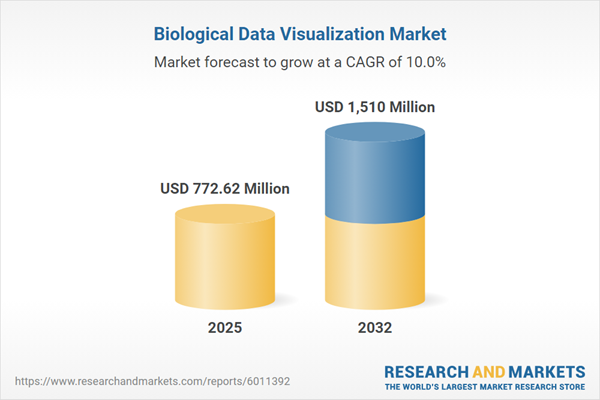Speak directly to the analyst to clarify any post sales queries you may have.
The Biological Data Visualization Market is evolving as a critical enabler for life science innovation. With escalating data complexity across genomics, imaging, and multi-omics research, organizations prioritize advanced visualization solutions for accelerated discovery and strategic decision making.
Market Snapshot: Biological Data Visualization Market Size & Growth
The Biological Data Visualization Market grew from USD 706.75 million in 2024 to USD 772.62 million in 2025. It is expected to continue growing at a CAGR of 10.02%, reaching USD 1.51 billion by 2032. Widespread adoption across pharmaceutical, clinical, agricultural, and environmental sectors, combined with rapid advancements in AI and interactive analytics, will drive sustained market expansion. Integration of multi-modal data and cloud delivery models is further lowering barriers to entry while boosting accessibility for both established organizations and emerging research teams.
Scope & Segmentation of the Biological Data Visualization Market
This report offers in-depth coverage of the biological data visualization ecosystem, with segment analysis across key domains. The study provides comprehensive insight into market structure and regional dynamics.
- Technology: Flow cytometry-based visualization, magnetic resonance imaging (MRI), mass spectrometry-based visualizations, microscopy-based visualization, sequencing-based visual analytics, X-ray crystallography solutions
- Data Type: Genomic data, metabolomic data, proteomic data, transcriptomic data
- Platform Type: Integrated bioinformatics suites, standalone visualization tools
- Device Type: Desktop and laptop applications, mobile and tablet applications
- Deployment Mode: Cloud-based, hybrid, on-premise solutions
- Application: Agriculture and horticulture science, clinical and medical research, marine biology and environmental science, including environmental DNA (eDNA) and marine microbiome visualization
- End-User: Pharmaceutical and biotechnology companies, research institutes, academic laboratories, government research centers
- Regions: Americas (United States, Canada, Mexico, Brazil, Argentina, Chile, Colombia, Peru), Europe (United Kingdom, Germany, France, Russia, Italy, Spain, Netherlands, Sweden, Poland, Switzerland), Middle East (UAE, Saudi Arabia, Qatar, Turkey, Israel), Africa (South Africa, Nigeria, Egypt, Kenya), Asia-Pacific (China, India, Japan, Australia, South Korea, Indonesia, Thailand, Malaysia, Singapore, Taiwan)
- Key Companies: Agilent Technologies, AnalyzeDirect, Candelis Corporation, Canon Medical Systems Corporation, Carl Zeiss AG, Clarivate, Danaher Corporation, Dotmatics, Esaote S.p.A, GE HealthCare Technologies, Golden Helix, Media Cybernetics by Roper Industries, MetaCell LLC, MR Solutions, Oxford Instruments, Pluto Bioinformatics, QIAGEN, Revvity, Salesforce, Scientific Volume Imaging, Siemens Healthineers, Tempus Labs, Thermo Fisher Scientific, Waters Corporation, ZONTAL INC.
Key Takeaways for Senior Decision-Makers
- Biological data visualization solutions convert complex scientific data into actionable visual insights, expediting research and supporting strong collaboration across disciplines and geographies.
- Adoption of cloud-native architectures and hybrid deployment models is democratizing access, enabling scalable use by both large enterprises and small research organizations.
- Recent advances in AI and interactive visualization tools are enabling automated data interpretation and predictive analytics, reducing dependence on manual analysis and supporting multidisciplinary teams.
- Open-source frameworks and modular plug-ins are fueling innovation, driving interoperability, and encouraging rapid uptake across academia, government, and industry.
- Tailored application modules support a wide range of domains from clinical diagnostics to environmental monitoring, aligning with regulatory and data privacy considerations unique to each region.
- Strategic alliances, including mergers and partnerships between hardware and software vendors, are streamlining integration and delivering end-to-end solutions for diverse research needs.
Tariff Impact on Supply Chains and Research Collaboration
The 2025 U.S. tariffs introduced complexity into biological data visualization supply chains, increasing costs for imported hardware and specialized reagents. Many organizations responded by enhancing domestic production, building new partnerships with local vendors, and accelerating adoption of modular, software-centric solutions. Research collaborations adapted as well, leveraging localized cloud platforms and advanced encryption to ensure compliance with evolving trade regulations. These shifts fostered supply chain resilience and prompted a strategic move towards globally balanced, agile technology deployments.
Methodology & Data Sources
The analysis combines primary interviews with industry experts and end-users, alongside extensive secondary research from peer-reviewed literature, company filings, and technical white papers. Findings are validated through triangulation, expert review, and alignment with current industry frameworks to ensure quality and relevance.
Why This Report Matters
- Supports informed investment and procurement decisions with complete, up-to-date intelligence across market segments and regions.
- Highlights emerging technologies and adaptable deployment strategies, guiding leaders to enhance innovation and regulatory compliance.
- Enables benchmarking of major industry players and new market entrants, assisting strategic planning in a competitive landscape.
Conclusion
Biological data visualization continues to underpin the advancement of life sciences, empowering organizations to adapt, innovate, and accelerate discovery. Decision-makers equipped with this report gain the clarity needed to navigate market shifts, drive collaboration, and sustain long-term growth.
Additional Product Information:
- Purchase of this report includes 1 year online access with quarterly updates.
- This report can be updated on request. Please contact our Customer Experience team using the Ask a Question widget on our website.
Table of Contents
3. Executive Summary
4. Market Overview
7. Cumulative Impact of Artificial Intelligence 2025
Companies Mentioned
The companies profiled in this Biological Data Visualization market report include:- Agilent Technologies, Inc.
- AnalyzeDirect
- Candelis Corporation
- Canon Medical Systems Corporation
- Carl Zeiss AG
- Clarivate
- Danaher Corporation
- Dotmatics
- Esaote S.p.A
- GE HealthCare Technologies Inc.
- Golden Helix
- Media Cybernetics, Inc. by Roper Industries, Inc
- MetaCell LLC, LTD.
- MR Solutions Ltd.
- Oxford Instruments PLC
- Pluto Bioinformatics
- QIAGEN GmbH
- Revvity, Inc.
- Salesforce, Inc.
- Scientific Volume Imaging B.V.
- Siemens Healthineers AG
- Tempus Labs, Inc.
- Thermo Fisher Scientific Inc.
- Waters Corporation
- ZONTAL INC.
Table Information
| Report Attribute | Details |
|---|---|
| No. of Pages | 190 |
| Published | November 2025 |
| Forecast Period | 2025 - 2032 |
| Estimated Market Value ( USD | $ 772.62 Million |
| Forecasted Market Value ( USD | $ 1510 Million |
| Compound Annual Growth Rate | 10.0% |
| Regions Covered | Global |
| No. of Companies Mentioned | 26 |









